Exploring Buenos Aires (by shank's mare and subway) - profmarcus
An unconventional guide to a fascinating city...
Getting Around
Ateneo
Buenos Aires Design Center
Museo Nacional de Bellas Artes
Cementerio Recoleta
Palermo Parks
Palermo Hollywood
Palermo Soho
Costanera Ecological Preserve
Buquebus hydrofoil ferry
Colonia, Uruguay
Feria Chacarita (new photo)
Cementerio Chacarita
Abasto (new photo)
Feria San Telmo
Eating (new photos)
Home Delivery
Internet and Phone
Taxis (new photo)
Language
A Typical Neighborhood (new)
(enter here)
Buenos Aires - the port city
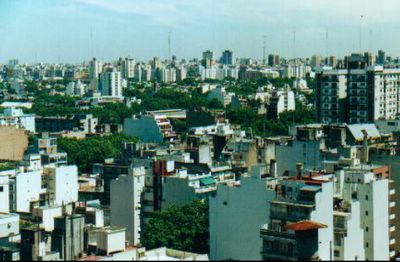
Looking out over Buenos Aires
There may be well over 15 million people in greater Buenos Aires (Gran Buenos Aires) but there is no need to be intimidated by its size. Yes, a lot of it is densely packed but somehow you never feel suffocated. The "busy-ness" is easily outweighed by the friendly people (many of them chatting on the sidewalks), the neighborhoods (Buenos Aires is virtually a city of neighborhoods) each with its own unique feel, the greenery (many streets are tree-lined and the parks are a treasure), the ease of getting around, and the many, many things to see and do. Even if your idea of relaxing is sitting around reading a good book over a cup of coffee, you will be in good company. Porteños, as the residents are known (literally, port city dwellers), love their cafés (confiterias) and their coffee and spend hours enjoying both. Needless to say, the people-watching is world-class.

Brujas ("Witches") Pizza Bar in Palermo Hollywood, a typical Porteño eatery and hang-out
My idea of getting to know a place is to jump right in to the local day-to-day comings and goings whether it be grocery shopping, going to work or school, browsing the mall, or just riding around on the subway. In Buenos Aires, there's no better way to do that than walking and using public transportation. Public transportation in BsAs (the accepted abbreviation for Buenos Aires) is excellent. Whether it's subway, train, taxi or bus, it's fast, reliable, safe, comfortable and inexpensive. Doctors, lawyers, laborers, storekeepers, professors, housewives, lovers, musicians, secretaries, schoolkids, and senior citizens all rub shoulders on busses, trains, and the subway and seem to be perfectly content to do it too.
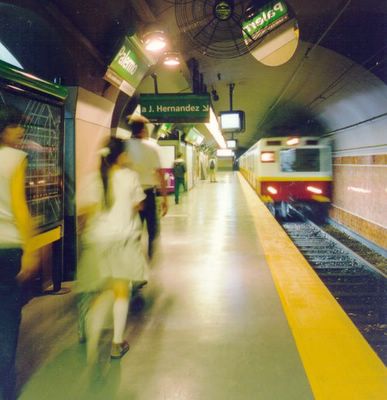
Subte, Estación Palermo
I’ve spent many, many hours exploring BsAs. Mostly, I’ve done it by walking and taking advantage of the terrific Subte (short for “Subterraneo”) system. This is a short, illustrated guide for those who, like me, enjoy getting out and about in the company of those who know a place best - the ones who live there. The suggestions I've sketched out here would keep the average person well-occupied for about a week, more or less, and that's assuming stout legs and an adventuresome spirit.
Getting around
First of all…
Be sure to get yourself a good (detailed, not just main thoroughfares), pocket-size street map that includes the Subte system.

BsAs Microcentro/"Downtown" (sample of detailed street map)
(For ease of orientation, the center and starting point for this guide is the intersection of Avenidas Santa Fe and Pueyrredón in Recoleta, the center of most everything. This would be a good time to check your map to make sure you know where I'm talking about.)
Once you've figured out where you are, go to the Pueyrredón Subte station and buy yourself a ten-trip Subtepass. This saves you from standing in line each time you want to go somewhere. (Tip: Always carry plenty of small change - 10 and 20 peso notes and smaller. NOBODY wants to give you change unless you're buying something and even then, if it's a small purchase and you offer a 50 or a 100-peso note, you will invariably be asked if you have something smaller.)

Subtecard (This is the rechargeable Subtecard for use in the system’s electronic card readers. Note: The 10-ride Subtepass is printed on card stock, not plastic, and has a different appearance.)
The Subte fare is approximately is 70 centavos (25 U.S. cents) per ride. Subte line "D" goes up and down Avenida Santa Fe (Santa Fe turns into Avenida Cabildo as it passes through Palermo) from Belgrano to the Microcentro. At roughly Avenida Pueyrredón it jogs to the Microcentro and ends at the Estación Catedral. Your days will often begin and end with Línea D.

Subte map: Teal - Line A; Red - Line B; Blue - Line C;
Green - Line D; Violet - Line E (click on map for larger view)
The Subte has its own TV system that not only keeps you up-to-date on system status and train frequencies, it also shows news and entertainment (and, unfortunately, commercials too, although some of the public service ads are terrific - a psa on condoms comes to mind). The rechargeable Subte card can also be used to purchase goods and services in Subte stations and to obtain discounts at movie theaters, restaurants and other establishments. Most all Subte cars have scrolling marquees that announce the next stop and some even tell you on which side of the car the doors will open! It's perhaps the cleanest, most efficient, most reliable, and cheapest system I've ever ridden.

Interior of Subte car showing scrolling marquee
Things to do and see
The very first thing to do, preferably the day you arrive, is visit the Ateneo bookstore. On Avenida Santa Fe between Avenidas Callao and Riobamba, the Ateneo is splendidly quartered in a beautifully restored theater dating from the days when even movie theaters were luxury venues. Have a cup of coffee (their coffee shop occupies the former stage) while you're nursing your jet lag and bask in one of the best bookstore atmospheres to be found anywhere. Cross the street to Restaurant La Farola for a good meal.

Interior of Ateneo
Something for a long day or perhaps two...
Walk to Cementerio Recoleta from Santa Fe and Pueyrredón.

Cementerio Recoleta (area bounded by Avenidas Vicente Lopez, Junín, Pueyrredón and Del Libertador)
In Recoleta you can see the tomb of Eva Peron and the "fantabulous" tomb architecture laid out like an exclusive neighborhood in a miniature city. From there, you can walk to the Buenos Aires Design Center where beautiful, innovative and expensive home decor items are featured in numerous locales (stores) in an old but thoroughly and creatively rehabbed setting complete with outdoor cafes where you can indulge in the BsAS pastime of people-watching.
Buenos Aires Design Center
From the Design Center, cross Avenida del Libertador (if you cross Avenida Alcorta, you've gone too far), and you'll be almost on top of the Museo Nacional de Bellas Artes, the country's premier fine arts museum.
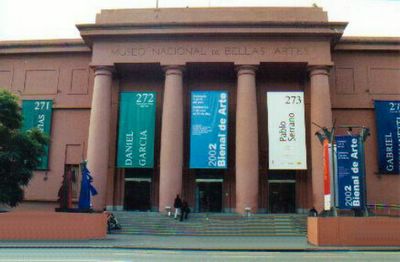
Museo Nacional de Bellas Artes
Standing in front of the museum as you're facing the street, turn and walk to your right. In the next block or so to your right you will see the parks that parallel Libertador. Walk through them and when you emerge look for Avenida Aguado. Follow Aguado almost to Alcorta and then take a left on Ortiz De Ocampo and look for Avenida Castex on your right.

Avenidas Aguado, Ortiz De Ocampo and Castex
Walk along Castex (the street takes a jog in the middle) and you will come to more parks. At that point, you can literally walk through parks all the way to Avenida de Los Incas, not on the maps here but, trust me, quite a hike.

Palermo parks and attractions
Along the way, you will pass the Japanese Garden (Jardín Japonés), the planetarium, the zoo (Jardín Zoológico - as you're walking, the zoo is a fair walk off to the left in an adjacent park), the Botanical Garden (Jardín Botánico, again to the left, beyond the zoo), the rose garden (Rosedal), the Hipodromo, the horse club, the golf club, and people walking, talking, sunning, picnicking and, of course, playing fútbol.

Japanese Garden (Jardín Japonés)
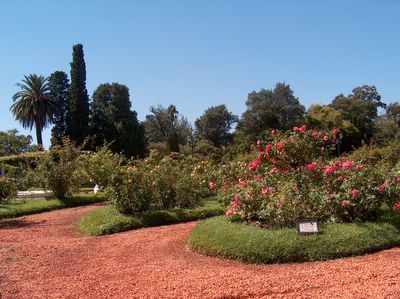
Rose Garden (Rosedal)
Along the way, there are statues, small lakes, fountains, plazas, plenty of open space, lots of greenery, and the ubiquitous paseaperros (professional dog walkers) who may have as many as 20 on the leash at once, all happy and wagging their tails. (Watch your step, always - parks, sidewalks, everywhere...!)

Paseaperro
At any point you can break out of the parks to your left and get refreshed at an outdoor cafe along Libertador or on one of the side streets. When your feet have had it, break out your Subtepass, locate the nearest station on Avenida Santa Fe/Cabildo (be sure to take the direction "Trenes a Catedral") and head back to your stop in Recoleta.

Avenida Santa Fe/Cabildo
Some Friday or Saturday night...
If you have the adventuresome spirit, take Subte Linea D to the Plaza Italia station (direction “Trenes a Congreso de Tucuman”). Cross Avenida Santa Fe and continue on Santa Fe in the same direction the train was heading (Congreso de Tucuman).

Avenidas Santa Fe, Godoy Cruz, Honduras and Juan B. Justo
After a few blocks, you will see the club, "New Metropolis" (Avenida Santa Fe 4389). This is one of several popular venues for the music that virtually every Argentine teen-ager listens to and goes wild over - Cumbia Villera (literally, "ghetto cumbia"). It has some of elements of rap but I find it a lot more enjoyable, a lot more musical, and have even picked up some cd's.
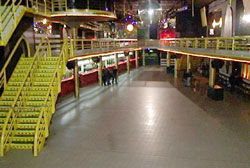
New Metropolis
One of the most interesting things, to me at least, is just how much fun these kids have. They don't have the angry, belligerent facade of so many American teens. They're a bit more relaxed and seem to be generally happier. Don't even think of showing up before 11 p.m.

Cumbia Villera group at Fantastico Bailable, another Cumbia
Villera venue
If you want to notch up your adventure a bit, before you go to New Metropolis, stay on Line D to the next station, Palermo. Intersecting Avenida Santa Fe at the Palermo station is Avenida Godoy Cruz. If you walk up Godoy Cruz without crossing Santa Fe, you will see old, graffiti-covered walls on one side with the up-and-coming trendiness of Palermo Soho on the other. If you time it right, between 9:30 and 10 at night, before you tackle New Metropolis, you will witness one of the best transvestite street shows anywhere. I accidentally stumbled across this interesting scene one cold (for BsAs) winter's night in July and was quite astonished. They’re out for pick-ups, of course, but they’re polite, funny and definitely having a good time. To be sure, this isn’t something you'll run across just anywhere. (If you’d rather not get hit on, you might want to consider a taxi rather than walking. You’ll be hit on in a taxi too but escape is quicker. Please note - I’ve never, ever had personal safety problems walking in BsAs but, as everywhere, dress like a local and act like you know where you're going and what you're doing – even if you don’t.)
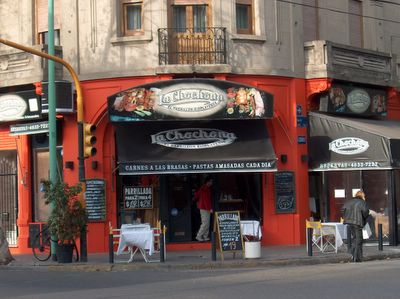
La Chochona Restaurant in Palermo Soho
If you keep walking up Godoy Cruz until the walls end, there’s a street where you can turn right (Avenida Honduras) that will take you across the commuter rail tracks and to the major street that parallels Godoy Cruz on the other side, Avenida Juan B. Justo. Cross J.B. Justo, staying on Honduras, and you will be in the thick of Palermo Hollywood, even trendier, believe it or not, than Palermo Soho. Palermo Soho and its upstart sibling, Palermo Hollywood, are both great fun if you like nifty little bistros, art galleries, unique designer clothing and mingling with the BsAs “in” crowd.
Any day...
Take Linea D to the end, Estación Catedral (direction "Trenes a Catedral"). When you emerge from the station, you will be across from Plaza de Mayo. From there you can see the "Pink House" (Casa Rosada), the seat of Argentina's government and, of course, the expansive plaza.

Casa Rosada
Keep walking toward Rio de la Plata, cross Avenidas Madero and Goritti. To cross Goritti, you will have to walk either left or right along the causeway until you reach a bridge. Once across the bridge, you will be in Puerto Madero, an area reclaimed from the river by dumping Subte construction debris.

Avenida Madero appears as Avenida Huergo
on this map. Goritti runs parallel to Madero
on one side and to the river channel on the
other. (See following picture.)

Downtown Buenos Aires viewed
from Puerto Madero
If you keep on heading toward the river, you will come to the Costanera ecological preserve, a terrific natural area with lots and lots of hiking paths, wildlife, birds, trees, pampa grass, and other native flora and fauna all of which colonized the area on top of the debris. With commendable foresight, it was declared a preserve rather than handing it over to developers.

Costanera Ecological Preserve

Costanera Ecological Preserve
Any day...
Take the Buquebus hydrofoil ferry to Colonia, Uruguay. (Note: The round-trip fare isn’t in the bargain category.) You will depart from the Buquebus ferry terminal at Darsena Norte on the western end of Puerto Madero, about 8-9 blocks from the Catedral Subte station.

Darsena Norte denoted by *
The ferry leaves about 11:30 a.m. and you should be there by 10-10:30 to get a ticket. The hydrofoil (made in Australia) is a marvel and it flat-out FLIES. It shaves the regular ferry ride from 3 hrs to 1 and is a most pleasurable experience.

Buquebus Ferry "Atlantic III"
There's a buffet restaurant onboard and the duty free shop would put a lot of airports to shame. Try to be one of the first onboard so you can get a window seat.

Passenger seating area, Buquebus
Ferry "Atlantic III"
Colonia is a great walking town and you can walk from the ferry terminal into town and back without breaking a sweat. There’s some great eating along the main drag and the UNESCO World Heritage site in the old town is definitely worth exploring. If you want to return to BsAs that day, the ferry leaves at 5:30 but keep in mind that Uruguay is one hour ahead of BsAs. There are some nice-looking hotels if you want to spend a night or two.

Decorative bus bench
Colonia, Uruguay

UNESCO World Cultural Heritage site
Old town, Colonia, Uruguay
For a Saturday or a Sunday...
Take Subte Linea D to Estación 9 de Julio and follow the signs for Linea B, direction "Trenes a Los Incas." (Pay close attention. It’s a bit of a walk and it can be confusing.) Take Linea B to Estación Dorrego. When you emerge on Avenida Corrientes, you will be across the street from the big Chacarita Saturday fair (Feria Chacarita) in Parque Los Andes.

Parque Los Andes with
Cementerio Chacarita in
upper left
This is a bona-fide BsAs flea market and a gringo is a rarity. Just walk around and enjoy. There’s everything from genuine antiques to fishing equipment to cell phone chargers (along with batteries to fit every model ever made and probably some that haven’t been invented yet), artisan items, food stalls, on and on.

Feria Chacarita
If you continue walking up Corrientes and follow the street that jogs to the left, you will come to Cementerio Chacarita, bigger than Cementerio Recoleta, and great for strolling. You can visit the tomb of Carlos Gardel, the famous tango singer, whose life-size statue often features a lit cigarette between his fingers.

Cementerio de la Chacarita
Across the street is the Federico Lacroze Subte and commuter train station where you can catch the Subte back to Estación Carlos Gardel (direction "Trenes a L.N. Alem"). Estación Carlos Gardel has direct access to the Abasto shopping center, a magnificent structure that, after being empty and neglected for many years, was completely re-done by investors (one of them being George Soros). It used to be the central vegetable market for BsAS. Be sure to go outside and walk around it to get the full benefit of the splendid architecture.

Abasto at night
Abasto has a great food court, a multi-screen cinema, a first-class arcade, and even amusement park rides. In the surrounding streets, you can find everything related to Argentine tango, Argentine crafts and Argentine artisan items including leather goods and accessories for the culture (and obsession) of maté. (Maté is a hot drink similar to tea and requires a much lengthier treatment than is possible here. Besides, a much better and considerably more pleasant way to learn about maté is to engage a Porteńo in conversation.)

Abasto looking down on food court
When you tire of Abasto, you can hop on the Subte and re-trace your morning journey back to Recoleta. (Direction "Trenes a L.N. Alem," change for Line D at Estación Diagonal Norte, direction “Trenes a Congreso de Tucuman.”)
For a Sunday...
Take Subte Linea D to Estación 9 de julio (direction "Trenes a Catedral") and follow the signs to Linea C (direction "Trenes a Constitucion"). Get off at Estación San Juan. When you exit the station, you will most likely be disoriented but that's ok. Just be sure to consult your map. Do NOT cross Avenida Bernardo de Irigoyen or the huge street that runs next to it, Avenida 9 de Julio. Instead, find Avenida San Juan (it runs at a 90-degree angle to Irigoyen) and walk down it AWAY from Irigoyen and 9 de Julio until you reach Avenida Defensa where you will turn left until you run into Plaza Dorrego.

Avenidas 9 De Julio, Bernardo De Irigoyen,
San Juan, and Defensa
You can't miss Plaza Dorrego because that's where the San Telmo flea market (Feria de San Telmo) will be in full swing. Unfortunately, that's also where tourists tend to congregate but it's still a must-see.

Plaza Dorrego and Feria San Telmo
If you keep walking down Defensa one block to Carlos Calvo and take a left, on the opposite side of the street almost at the next corner is the Mercado San Telmo, not so many tourists and loaded with all kinds of interesting things. It's an original but, then, so is San Telmo.
Eating…
Breakfast –
- cortado (small espresso cut with hot water and a little sugar), café con leche, cappuccino, doble espresso, café frappe, or you-name-your-coffee, all rich and full of flavor…
- medialunas (half-moons) are basically croissants (but substantial, not fluffy) that come in two varieties, grasa (literally, “grease,” signifying ingredient rather than mode of preparation) and manteca (butter)…
Lunch –
Many restaurants and confiterias offer a “menu del dia,” the daily special, usually good, filling and cheap. Be sure to check the menus too because they’re usually extensive.
Dinner –
There’s no end of restaurants and they range from local, family-type establishments to the big, fancy and expensive. I prefer the former. You can always tell a good place to eat the same way you pick good eateries everywhere else in the world - by how many people are inside. A national dish, ñoquis, flour dumplings served with a rich sauce of your choice, is delicious, hearty, and deadly for the waistline. The locals love pizza and there are more pizza places, both eat-in and carry-out, than you can imagine. Again, the rule of thumb: the more heavily patronized, the better. Note: Porteños have a horror of eating dinner before 9:30-10 p.m. and many don’t even head out until after 11. The good places are packed on Friday and Saturday nights.
Ice cream –
I would be terribly negligent and probably also in denial if I didn’t mention the abundance of excellent heladerias (ice cream shops), featuring the real homemade stuff, that are everywhere, often two or three to a block.

A sample of ice cream flavors
Cooking for yourself –
Go crazy. The big supermarket chains (Coto, Norte, Plaza Vea) have everything imaginable. The bigger stores are European-style hypermarts with clothing, hardware, and just about everything else.The Coto on Cabildo just down from Avenida Federico Lacroze is a real adventure as is the one across the street from the Abasto shopping mall. There are smaller, mom-and-pop supermercados on every block. Immigrant Chinese and Koreans have snared a chunk of this niche market. And, of course, there are specialty meat and vegetable markets, fresh pasta stores, and wonderful bakeries.

Coto at Abasto
Unsolicited restaurant recommendation –
For a place that has genuine Argentine parillada and asado (mixed grill and barbecue), a friendly neighborhood atmosphere, local (as opposed to gringo) prices, no gringos, good food, and a nice selection of Argentine wines, Restaurant Don Lechón can't be beat. (By the way, if you enjoy good wine, Argentine wines are one of the better-kept secrets and ridiculously inexpensive!)

Restaurant Don Lechón
Don Lechón sits where the Villas (city government subsectors) of Colegiales and Ortuzar come together. Just give any taxi driver the name of the place and tell him it's at the intersection of Avenidas Elcano and Alvarez Thomas. Go after 9 p.m.

Restaurant Don Lechon denoted by *
Home delivery…
Note for the couch potato: Literally EVERYTHING that is available for purchase in Buenos Aires can be ordered via phone and delivered to your door. It doesn’t matter whether it’s fast food, restaurant food, groceries, pharmacy items, hardware, or anything else, EVERYBODY delivers “sin cargo” (“without charge”).
Internet and phone…
No problem here. Particularly when you get out of the Microcentro (downtown), “cibers” (internet cafes) and locutorios (telephone storefront businesses that often have internet available and, frequently, bill-paying services as well) are omnipresent. The cibers often cater to kids and teens and feature a huge selection of juegos en red (networked computer games) and sometimes arcade games. The locutorios tend to draw a more adult clientele and consequently are a bit more expensive than the cibers (1.5 - 2 pesos per hour vs. 1 peso per hour for the cibers). For the most part, if you patronize an internet business in one of the more upscale neighborhoods (Palermo, Belgrano, etc.) and/or downtown, you will pay more (2 - 2.5 pesos an hour). Phone calls to the U.S. are roughly 1.5 - 2 pesos a minute.

Locutorio with internet
Taxis...
The black and yellow BsAs taxis are terrific. They cruise the streets in packs, looking for fares. The drivers are often older gentlemen, friendly and helpful. All taxis are fare-regulated and the most I ever paid was 13 pesos ($4.50 U.S.) and that was to go from one end of town to the other. You can flag them down anywhere and you know they're available when the red "libre" (“free”) light on the upper passenger-side windshield is lit. No need to tip but if you get in or get out somewhere where someone is waiting to open the door for you, give him a peso - that's how he's making his living.

BsAs Taxi
Language...
Note: In BsAs, it's not Español (Spanish), it's "Castellano." Argentines pronounce the double-“ll” as "sh" instead of "y," so it's "Cas-ta-'shano" instead of "Cas-te-yano" and "'Vee-sha" instead of "Vee-ya" (villa). An "s" is often pronounced "sh" as well - "mash-o-'nesa" instead of "my-o-'nesa" (mayonnaise). If you've learned Mexican Spanish as I have, this takes some real adjustment. Besides all that, Porteño speech is very unique in its idioms. "Che, boludo!," which means literally, "Hey, turd!" is often used with close friends and NEVER with casual acquaintances. "Fua!" is the Porteño expression for "wow," "amazing," "holy cow," etc. Hand gestures are also interesting and most of the time don't mean what you might think. In all seriousness, I have found that the more I slur, lisp and mumble, the better I'm understood.
A typical neighborhood...
No two neighborhoods in Buenos Aires are the same. They may have a lot of the same kinds of stores and services but they all have their own unique feel. Here's a sample of a typical neighborhood in the same general area as Restaurant Don Lechón (see above), spanning Avenidas Forest, Elcano, and Alvarez Thomas.

A montage, clockwise from upper left: the pharmacy, the grocery store, the pizza parlor, and the laundry.
For some reason, the logo of this poultry shop caught my eye. The name of the store is, in English, "This is my chicken" or, in Castellano, "Este es mi pollo."

Este es mi pollo
The proprietor is in the background, waving hello.
You occasionally run across some wonderful classic cars in Buenos Aires. This old Citroen has obviously received a lot of TLC.

Classic Citroen
Argentina has a world-wide reputation for manufacturing outstanding fireworks and producing world-class displays. One of the best, Jupiter, sits on the corner of Virrey Loreto and Alvarez Thomas.

Fuegos Artificiales Jupiter
What would any neighborhood be without an occasional scene like this - a cable tv installer, trying to untangle the cable wire from a tree so he can attach it to the cable box on the upper line while leaning his metal ladder against the lower wires?

Cable installer
And, what better way to end a nice afternoon of walking around the 'hood than watching a glorious sunset from the park.

(more to come)





5 Comments:
thanks... if you would like to be put in touch with some youthful and rabid river plate and boca juniors fans, let me know... :)
Muy buena radiografía de nosotros!... Espero les guste nuestro país!
Really a good x-ray of us!...
I hope you like our country!
just to make things clear, the "sh" is only used in buenos aires and rosario, the rest of the country speaks way different (much like the difference between a texan and a new yorker!)
although "boludo" is commonplace.
It's one of the best introduction to this fascinating
metropolis I ve ever read. I myself lived in BsAs for about 15 months and I can confirm your coments.
By the way , a normal tourist who travels according to the slogan make Argentina in 10 days doesn:t see the jewels BSAs offers. You must take the time and walk in the streets of the city at Rio del la Plata.,the only way , to my mind, to feel the spirit of
BsAs,reading if you like, Borges' Fervor de Buenos Aires.
Nice! I'm going to link to
Da Noise...
When can we expect a post on
tango?
Post a Comment
<< Home